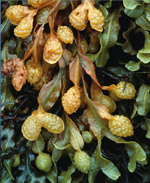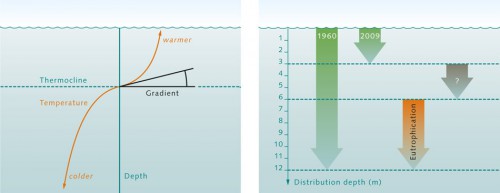
Biological systems under stress
Changing habitats
Stress is a common phenomenon nowadays. Not only people suffer from stress. Marine plants and animals are also subject to stressors – pressures brought on by changes in their habitat conditions. Stress has been around forever. But it has clearly been intensifying in recent years as a result of climate change. Sometimes stress is triggered by just one stressor. In the ocean, for example, it could be due to increased sedimentation from a storm burying bottom dwellers, or an algal bloom causing light deficiency in deep water layers. Unfortunately, however, climate change often introduces several stressors at the same time, leading to “multiple stress”. At a particular location and time, the temperature, light availability and pH can all drift outside the range optimal for an organism. Sometimes introduced species can also act as stressors – as predators, pathogenic agents, or feeding competitors.
As an additional complicating factor, the various stressors do not always act independently. In some cases the effects can be additive, or even amplified. This amplification does not lead inevitably to immediate death. In many cases the stressors initially only impair the productivity of an organism in some way. Interactions of the weakened organism with its environment, with predators, parasites, competitors, pathogens or reproductive partners are thus altered. These effects can significantly exceed the primary effects of the stressors such as the stress caused by light deficiency. The various linkages are further illuminated in the example of the bladderwrack seaweed described below.
Too many environmental changes at once
The most common stressors on marine ecosystems amplified by climate change include:- gradual acidification of seawater, accompanied by inhibition of the calcification process, which is the formation of calcium carbonate by marine organisms;calcification process, which is the formation of calcium carbonate by marine organisms;Further information on this topic is available here:
- warming of seawater and associated secondary effects, including more pronounced stratification of the water column, increased metabolic rates of the organisms, or changes in the solubility constants, which affect the amounts of certain dissolved substances in the water such as gases or carbonates;
- an increase or decrease in salinity in marginal seas, and the accompanying adverse effects on the ion budgets of living cells;
- eutrophication, which is an excessive accumulation of nutrients,eutrophication, which is an excessive accumulation of nutrients,and other kinds of chemical pollution of seawater. Climate researchers predict increased precipitation rates for wide areas of the Baltic Sea region in the future. Increased rainfall washes more fertilizer from farmland into the sea;Further information on this topic is available here:
- changes in near-coastal current and sedimentation processes caused by human construction projects,changes in near-coastal current and sedimentation processes caused by human construction projects,which, in part, may be carried out as a response to climate change and rising sea levels. These include harbours, breakwaters and dykes;Further information on this topic is available here:
- the spread of exotic species into new habitats.the spread of exotic species into new habitats.The compositions of communities will doubtless be changed as a result of multiple stress. In addition, geographic distribution zones could shift so that species die out in their native habitats. It is also conceivable that exotic species could become newly established in regions outside their former range.Further information on this topic is available here:
- gradual acidification of seawater, accompanied by inhibition of the calcification process, which is the formation of calcium carbonate by marine organisms;
Bladderwrack – a species under constant stress
The bladderwrack Fucus vesiculosus, is a seaweed of temperate latitudes commonly found in the North and Baltic Seas. It primarily colonizes the intertidal zone, but can occasionally occur in water depths of up to 12 or even 15 metres. The bladderwrack serves a number of important functions in the ecosystem. It is both a food source for various organisms and an important provider of oxygen. It offers protection for juvenile animals and serves as a substrate upon which diverse species can colonize. Its population in the western Baltic Sea has decreased by more than 90 per cent over the past four decades – in many areas it is no longer observed at depths of 12 metres, but only down to 3 metres. Its decline at greater depths has long been attributed to eutrophication – an environmental stressor (Chapter 4). It was presumed that an overabundance of nutrients in the water led to an increased density of plankton blooms, which restricts the amount of light penetration reaching the sea floor. Furthermore, it was assumed that a light deficiency on the sea floor during a plankton bloom would limit the bladderwrack’s ability to defend itself against predators.
- In addition, it appears that under decreasing light conditions the bladderwrack is less able to defend itself against bacteria. But this explanation is inadequate, first because the bladderwrack can store energy and therefore survive darker periods, and second because it can still thrive under very low light conditions. Even considering that increased numbers of organisms such as microalgae grow directly on the bladderwrack’s surface under eutrophic conditions, leading to added competition for light and food between the algae and the seaweed, it still should be able to survive down to 6 metres. Only below this depth would the energy deficit caused by light deficiency and feeding competition be severe enough to be fatal. So this alone cannot explain why the plant is becoming scarce at depths below 3 metres.
- 5.2 > The bladderwrack Fucus vesiculosus is widely distributed throughout Europe. It could die out in some areas as a result of climate change.

- 5.3 > The boundary zone between warm, near-surface waters and the deeper cold waters is called thermocline. The gradient is a measure of how rapidly the temperature changes in the thermocline. A high gradient means rapid changes over short depth intervals. 5.4 > In 1960 the bladderwrack could be found to a depth of 12 metres in the western Baltic Sea; in 2009 only down to 3 metres. The light deficiency caused by eutrophication contributed significantly to its disappearance between 6 and 12 metres – yet it cannot explain its absence between 3 and 6 metres.
 Now it is believed that the decrease in bladderwrack abundance at the relatively shallow depths of between 3 and 6 metres has other causes: For one, the warming of seawater, which can be clearly detected today, leads to a general increase in metabolic rates, so that predators become hungrier and bacterial attacks more intense. In addition, abrupt temperature differences at changing water depths impair the capability to defend against aggressors. In the summer a thermocline is often present, precisely at depths of around 4 to 5 metres. The distinctive temperature change here within a few centimetres of water depth becomes even more pronounced as the water temperature rises. If the depth of the thermocline oscillates up and down, a bladderwrack living at these depths experiences rapid and large temperature fluctuations – which diminishes its defensive capability.
Furthermore, a new biotic stressor has appeared in recent years: the red algae Gracilaria vermiculophylla, which was introduced from South-East Asia. The habitat requirements of this species are very similar to those of the bladderwrack. The problem is that, unlike the bladderwrack, the red algae can reproduce asexually, which makes it especially prolific. Furthermore, it is more tolerant of fluctuations in local abiotic conditions and also less attractive to predators. And still further, predators of the bladderwrack even use the red algae as a protective cover to hide from their own enemies. Another problem is that chemical secretions from Gracilaria diminish the germination potential of Fucus eggs.
Now it is believed that the decrease in bladderwrack abundance at the relatively shallow depths of between 3 and 6 metres has other causes: For one, the warming of seawater, which can be clearly detected today, leads to a general increase in metabolic rates, so that predators become hungrier and bacterial attacks more intense. In addition, abrupt temperature differences at changing water depths impair the capability to defend against aggressors. In the summer a thermocline is often present, precisely at depths of around 4 to 5 metres. The distinctive temperature change here within a few centimetres of water depth becomes even more pronounced as the water temperature rises. If the depth of the thermocline oscillates up and down, a bladderwrack living at these depths experiences rapid and large temperature fluctuations – which diminishes its defensive capability.
Furthermore, a new biotic stressor has appeared in recent years: the red algae Gracilaria vermiculophylla, which was introduced from South-East Asia. The habitat requirements of this species are very similar to those of the bladderwrack. The problem is that, unlike the bladderwrack, the red algae can reproduce asexually, which makes it especially prolific. Furthermore, it is more tolerant of fluctuations in local abiotic conditions and also less attractive to predators. And still further, predators of the bladderwrack even use the red algae as a protective cover to hide from their own enemies. Another problem is that chemical secretions from Gracilaria diminish the germination potential of Fucus eggs.
So Fucus is clearly exposed to a number of stressors along with their direct and indirect effects: light reduction, colonization and predator pressure, and competition with algae for nutrition. All of these together hinder its growth and germination processes. The Fucus population is thus experiencing an ever decreasing ability to offset its losses from predation and competition. The example of Fucus clearly illustrates that, although the direct effects of climate change alone may be minor, they are nevertheless devastating because of changes in the interactions among various organisms.